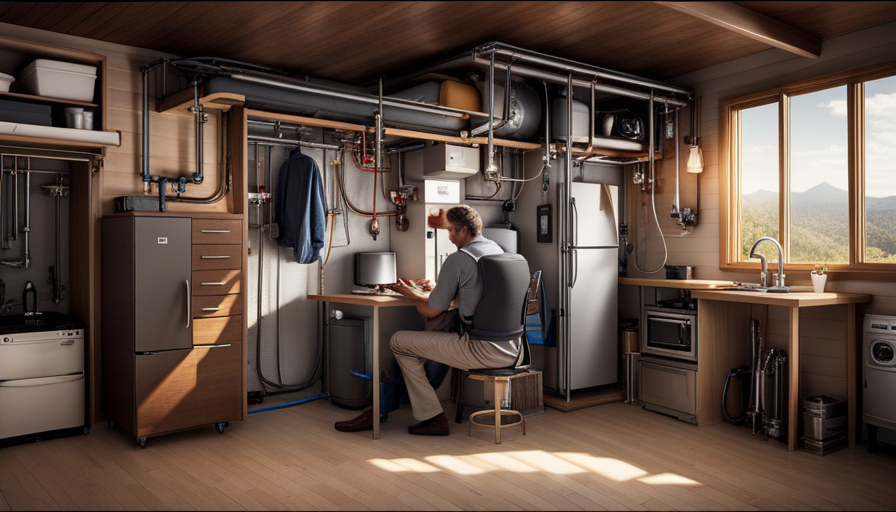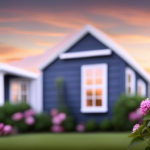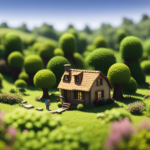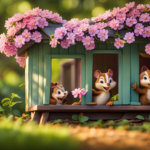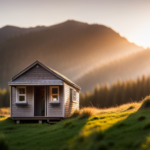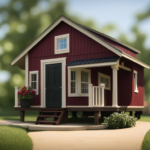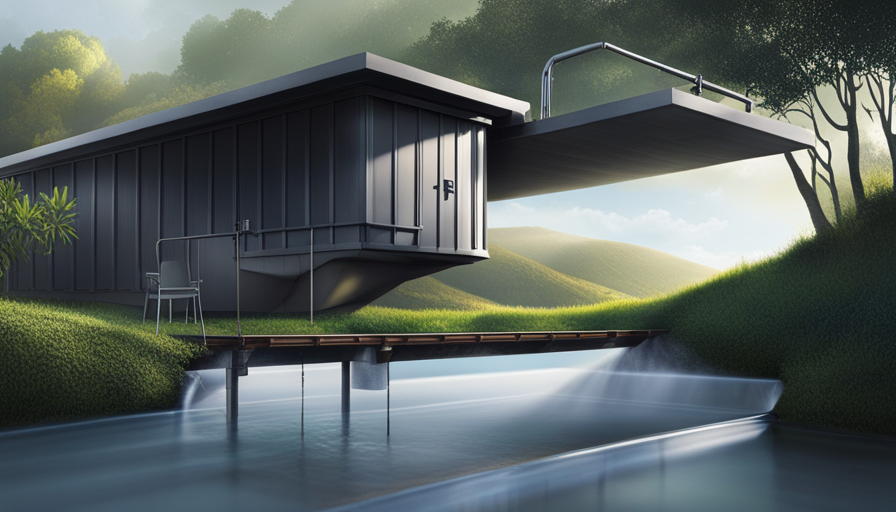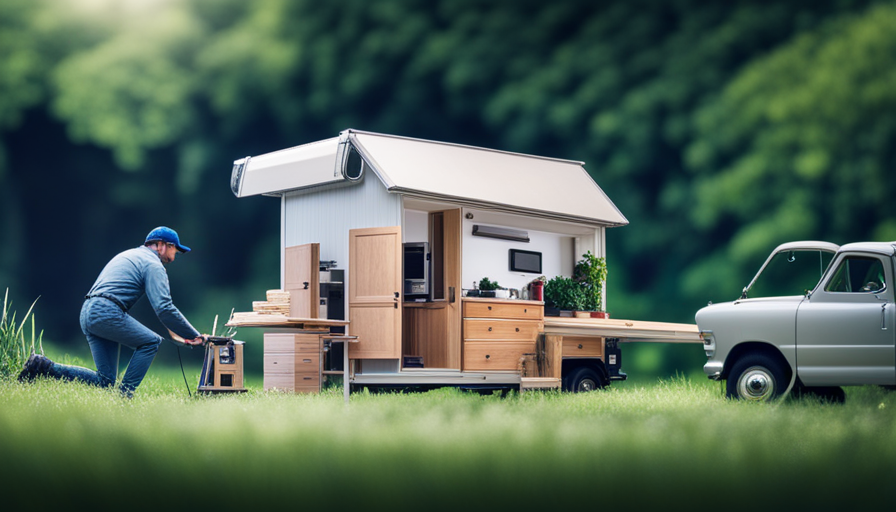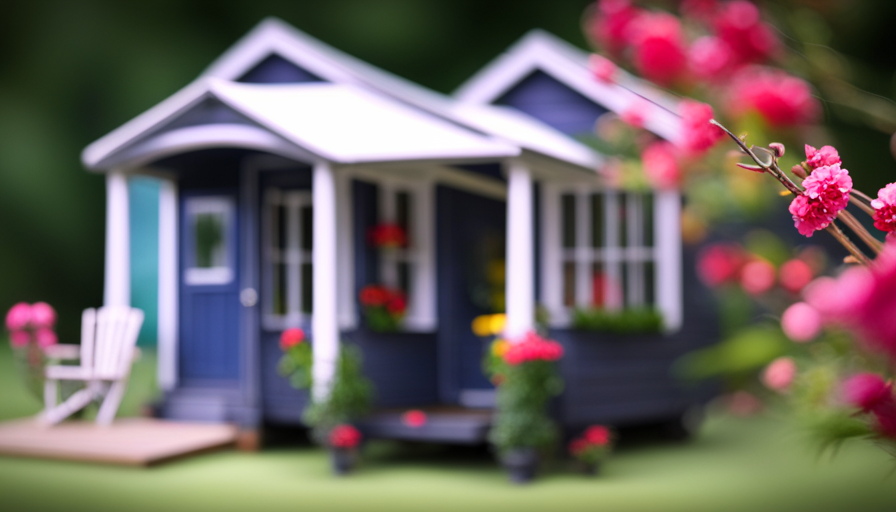When thinking about tiny homes, the common question is: how much space does each person get? If you’re curious, follow the link to learn more about maximizing space in tiny homes and making the most out of every square foot. Discover the secrets to living comfortably in a small space and get inspired to downsize without sacrificing comfort. Explore innovative solutions for storage, furniture, and layout to create a cozy and functional living space. Dive into the world of tiny homes and unlock the potential of living big in a small space!
This seemingly simple inquiry holds a profound significance as it challenges conventional notions of space and living. In a world where excess is the norm, the tiny house movement dares to defy societal expectations, urging us to reconsider our priorities.
By juxtaposing the scarcity of square footage with the abundance of creativity and resourcefulness, tiny houses exemplify the art of living minimally without compromising comfort.
In this article, we will delve into the world of tiny houses, exploring their average sizes, various designs, and the ideal square footage per person. Get ready to embark on a journey that will challenge your perception of space and inspire you to embrace a more sustainable and minimalist way of life.
Key Takeaways
- Tiny houses challenge conventional notions of space and living
- Tiny houses range in size from 100 to 400 square feet per person
- Tiny houses offer all necessary amenities despite limited space
- Living in a tiny house reduces environmental impact and increases financial freedom
Understanding the Concept of Tiny Houses
Do you ever wonder how much space you really need to live comfortably? Well, in a tiny house, you’ll be amazed at how few square feet per person can be enough!
Tiny houses have gained popularity in recent years due to their unique concept of minimalistic living. Exploring the benefits of tiny houses, one can find that they promote a simpler lifestyle, reduced environmental impact, and increased financial freedom.
Contrary to common misconceptions, living in a tiny house doesn’t mean sacrificing comfort or convenience. These compact dwellings are ingeniously designed to optimize every inch of space, with clever storage solutions and multifunctional furniture. The square footage per person in a tiny house typically ranges from 100 to 400 square feet, depending on the design and layout.
Despite the limited space, these houses offer all the necessary amenities, including a kitchen, bathroom, and sleeping area. Additionally, the open floor plan and large windows create an illusion of spaciousness.
So, let’s now delve into defining the average size of a tiny house and explore the possibilities it offers for a minimalist lifestyle.
Defining the Average Size of a Tiny House
Imagine living in a cozy home that perfectly accommodates your needs, providing just the right amount of space for each individual. This is the beauty of a tiny house, where efficiency and minimalism are key.
When it comes to the average size of a tiny house, it typically ranges between 100 and 400 square feet. Now, you might be wondering how such a small space can be enough for a person. Well, the benefits of tiny house living lie in its clever design and utilization of space. Every square inch is carefully planned and optimized to ensure maximum functionality. From multi-purpose furniture to smart storage solutions, tiny houses make the most out of their limited square footage.
Moreover, the compact size encourages a simpler and more sustainable lifestyle, as it requires fewer resources to heat, cool, and maintain. This not only reduces your carbon footprint but also saves you money in the long run. So, while the average size of a tiny house may be small, its benefits are anything but.
Now, let’s explore the different types of tiny house designs and see how they can further enhance your living experience.
Exploring the Different Types of Tiny House Designs
In the vast tapestry of tiny living, a variety of design styles unravel, each with their own unique charm and functionality. When it comes to tiny house designs, there are several different styles to choose from, ranging from sleek and modern to rustic and cozy. To give you a better understanding of the options available, here is a table showcasing four popular tiny house styles:
| Style | Description | Key Features |
|---|---|---|
| Modern | Clean lines, minimalist aesthetic | Large windows, open floor plan |
| Traditional | Classic design, homey atmosphere | Gable roof, front porch |
| Rustic | Natural materials, rustic charm | Log cabin-inspired, wood accents |
| Contemporary | Unique and unconventional design | Rooftop garden, unconventional shapes |
These different styles offer a range of choices for those looking to embrace the tiny house lifestyle. However, regardless of the style chosen, one common goal is to maximize storage space. This is achieved through innovative solutions such as built-in furniture, hidden storage compartments, and multi-purpose furniture pieces. By incorporating these strategies, tiny house dwellers can make the most of their limited square footage. Transitioning into the next section about maximizing space efficiency, it is essential to explore the practical techniques that can help achieve this goal without compromising comfort.
Maximizing Space Efficiency in a Tiny House
Get ready to unlock the full potential of your small space by discovering clever strategies for maximizing the efficiency of your tiny home. When it comes to tiny house living, every square inch counts, so it’s important to make the most of the space you have.
Here are some key tips for maximizing storage and finding creative space solutions:
-
Utilize vertical space: Install shelves, hooks, and hanging organizers on walls to make use of the vertical space in your tiny house. This will free up valuable floor space and keep your belongings organized and easily accessible.
-
Optimize multifunctional furniture: Invest in furniture pieces that serve multiple purposes, such as a sofa that can transform into a bed or a dining table that doubles as a workspace. This will help you make the most of limited square footage and avoid clutter.
-
Embrace hidden storage: Look for opportunities to incorporate hidden storage solutions, such as under-bed storage drawers, built-in cabinets, or ottomans with hidden compartments. This will allow you to keep your belongings out of sight and maintain a clean and organized living space.
By maximizing storage and implementing creative space solutions, you can create a functional and comfortable living environment in your tiny home.
Now, let’s consider the ideal square footage per person in a tiny house.
Considering the Ideal Square Footage per Person in a Tiny House
Discover the optimal space allocation for each individual in your compact living environment by considering the ideal square footage. When designing a tiny house, it’s crucial to determine the right amount of space per person to ensure comfort and functionality.
The ideal square footage for each person in a tiny house can vary depending on specific needs and preferences, but there are some general guidelines to consider. Tiny house designs often prioritize efficient use of space, so it’s important to maximize every square foot.
The ideal square footage per person in a tiny house typically ranges from 100 to 400 square feet. This allocation allows for a comfortable living space while still maintaining a compact and efficient layout. It’s essential to consider factors such as the number of occupants, lifestyle requirements, and personal preferences when determining the ideal square footage per person.
In the subsequent section about factors to consider when determining square footage per person, we’ll delve into more specific considerations that can help you determine the perfect amount of space for your tiny house.
Factors to Consider When Determining Square Footage per Person
Consideration of various factors is crucial when determining the ideal amount of space for each individual in a compact living environment. Factors to consider include the number of occupants, lifestyle preferences, and necessary amenities. By carefully assessing these elements, one can determine the ideal square footage per person in a tiny house.
To illustrate the importance of these factors, let us consider a three-column and three-row table:
| Factor | Importance | Impact |
|---|---|---|
| Number of Occupants | High | Affects overall square footage needed |
| Lifestyle Preferences | Medium | Determines space allocation for specific activities |
| Necessary Amenities | Low | Influences the amount of space required for utilities |
The number of occupants plays a significant role in determining the square footage per person. More occupants generally require more space to accommodate everyone comfortably. Additionally, lifestyle preferences, such as the need for a home office or a dedicated hobby area, will impact the desired square footage. Lastly, necessary amenities, such as a full kitchen or bathroom, will also affect the overall space requirements.
Taking these factors into account, we can better understand how to determine the ideal square footage per person in a tiny house. By considering the number of occupants, lifestyle preferences, and necessary amenities, we can optimize the living environment to suit individual needs.
Now, let us explore real-life examples of tiny houses and their square footage per person.
Real-life Examples of Tiny Houses and Their Square Footage per Person
Real-life examples of petite dwellings showcase diverse dimensions that perfectly suit occupants’ preferences. These tiny houses are designed with space efficiency in mind, utilizing every square foot to its maximum potential.
Take, for instance, the ‘Tumbleweed’ tiny house, which measures only 100 square feet. This compact dwelling is ingeniously designed to accommodate one person comfortably, providing all the essential amenities within its limited space.
Another example is the ‘Minim House,’ a tiny home that measures around 200 square feet. Despite its small size, it features a clever layout that includes a loft bedroom, a functional kitchen, and a cozy living area.
These real-life examples demonstrate how tiny houses can be both aesthetically pleasing and practical, proving that living in a small space doesn’t mean sacrificing comfort or style.
Transitioning into the subsequent section about the pros and cons of living in a tiny house with limited square footage, it is important to weigh the benefits and drawbacks of such a lifestyle.
Pros and Cons of Living in a Tiny House with Limited Square Footage
Living in a cozy compact space like a tiny house can ignite a sense of freedom and simplicity, but it also requires careful consideration of the trade-offs involved. There are both pros and cons of tiny house living that should be taken into account.
On the positive side, living in a small house means lower expenses and reduced environmental impact. With limited square footage, it becomes easier to maintain and clean the house. Additionally, a tiny house promotes a minimalist lifestyle, encouraging individuals to prioritize experiences over material possessions.
However, there are challenges to living in a small space. Lack of storage can be a major drawback, requiring creative solutions to maximize space. It may also be difficult to entertain guests or have privacy within the limited square footage. Nonetheless, by utilizing smart storage solutions, optimizing furniture arrangements, and incorporating multi-functional elements, it is possible to make the most of a small house.
These tips for maximizing space in a small house will help ensure comfortable living in a tiny house while making the most of the limited square footage. Transitioning into the subsequent section about ‘tips for living comfortably in a small space,’ it is important to consider various strategies to make a tiny house feel more spacious and functional.
Tips for Living Comfortably in a Small Space
Living in a tiny house with limited square footage can have its challenges, but with some careful planning and organization, it’s possible to live comfortably in a small space. Here are some tips for making the most of your tiny home:
-
Maximize vertical space: Utilize wall-mounted shelves, hooks, and storage units to free up floor space and keep your belongings organized.
-
Create multi-functional spaces: Choose furniture that serves multiple purposes, such as a sofa that can also be used as a bed, or a dining table that can double as a workspace.
-
Think outside the box: Get creative with your storage solutions by using under-bed storage containers, hanging shoe organizers, or magnetic strips for storing kitchen utensils.
By implementing these tips for organizing and creating multi-functional spaces, you can optimize the limited square footage of your tiny house. This will not only help you keep your living space neat and tidy but also make it more functional and comfortable to live in.
Transition: Embracing minimalism and sustainable living in a tiny house goes beyond just organizing and creating multi-functional spaces. It involves a mindset shift towards a simpler and more eco-friendly lifestyle.
Embracing Minimalism and Sustainable Living in a Tiny House
Embrace the minimalist lifestyle and sustainable living in your tiny home by incorporating eco-friendly practices like composting and using renewable energy sources. For example, imagine powering your tiny home with solar panels and growing your own food in a small garden, creating a self-sufficient and environmentally conscious living space.
When it comes to designing the interior of your tiny house, adopting minimalist principles is key. By keeping only the essentials and avoiding clutter, you can create a sense of spaciousness and tranquility. Opt for multifunctional furniture pieces that serve multiple purposes, such as a sofa that can also be converted into a bed or storage units that double as seating areas.
Additionally, choose eco-friendly materials for your tiny home construction. Consider using reclaimed wood, bamboo, or recycled materials for flooring, countertops, and cabinetry. These materials not only reduce the environmental impact but also add a unique and natural touch to your living space.
Remember, a minimalist and sustainable lifestyle in a tiny home is not just about reducing physical possessions, but also about making conscious choices that prioritize the well-being of the planet.
Frequently Asked Questions
What are the legal restrictions for building a tiny house?
When building a tiny house, it is important to consider the legal implications and zoning regulations. These restrictions vary depending on the location and often dictate the size, placement, and usage of the structure.
How can I finance the construction of a tiny house?
To finance the construction of a tiny house, I recommend exploring various financing options such as personal loans, RV loans, or crowdfunding. It is crucial to create a detailed budget plan to ensure financial feasibility.
Are there any specific building codes or regulations that apply to tiny houses?
There are specific building codes and zoning regulations that apply to tiny houses. These regulations ensure the safety and proper construction of tiny houses, including requirements for size, utilities, and location.
How much does it cost to maintain a tiny house on a monthly basis?
Maintaining a tiny house costs significantly less than a traditional home. For instance, my monthly expenses include $100 for utilities and $200 for insurance, while my friend in a regular-sized house pays over $500 for the same services.
Can I live in a tiny house with a family or is it only suitable for individuals or couples?
I can live in a tiny house with my family as it provides enough living space for all of us. Additionally, it is cost-efficient due to its smaller size, reducing maintenance and utility costs.
Conclusion
In conclusion, living in a tiny house may initially seem daunting due to its limited square footage per person. However, just like a diamond shines brighter when cut, a tiny house can illuminate the beauty of simplicity and sustainable living.
By embracing minimalism and maximizing space efficiency, individuals can create a cozy and functional home. Although it may be a challenging journey, the rewards of living in a tiny house are immeasurable, like finding a hidden treasure that brings joy and fulfillment.
So, dare to downsize and discover the true essence of living.
Hi, I’m Emma. I’m the Editor in Chief of Tiny House 43, a blog all about tiny houses. While tree houses are often associated with childhood, they can be the perfect adult retreat. They offer a cozy space to relax and unwind, surrounded by nature. And since they’re typically built on stilts or raised platforms, they offer stunning views that traditional homes simply can’t match. If you’re looking for a unique and romantic getaway, a tree house tiny house might just be the perfect option.

